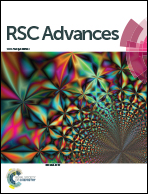Easy access to nitrogen-doped mesoporous interlinked carbon/NiO nanosheet for application in lithium-ion batteries and supercapacitors†
Abstract
We report a simple route to synthesis nitrogen-doped mesoporous interlinked carbon/NiO nanosheet that consist of carbon nanosheets and monodisperse NiO nanoparticles embedded in them homogeneously. The nitrogen-doped mesoporous interlinked carbon/NiO nanosheet with carbon content of 46% was obtained through directly low temperature heat treatment of Ni-ZIF-8 with a rapid heating rate (5 °C min−1). During the heat treatment, a large number of mesoporous were formed in the product with the evaporation (or thermal decomposition) of the organic ligand. When tested as an anode for lithium ion batteries (LIBs), the unique structure of the mesoporous carbon/NiO nanosheet not only shortened electro- and iron-transport pathways but also accommodated the volume change during Li+ intercalation and deintercalation process, resulting in a reversible capacity of 627 mA h g−1 at 0.5 A g−1 after 300 cycles. Moreover, the as-assembled carbon/NiO nanosheet supercapacitor can also exhibit an excellent cycling performance (414 F g−1 at 5 A g−1) with 92.2% specific capacitance retention after 3000 cycles by combined the pseudocapacitive behavior of the NiO nanoparticles with the electric double-layer capacitors (EDLCs) of the nitrogen-doped mesoporous carbon.


 Please wait while we load your content...
Please wait while we load your content...